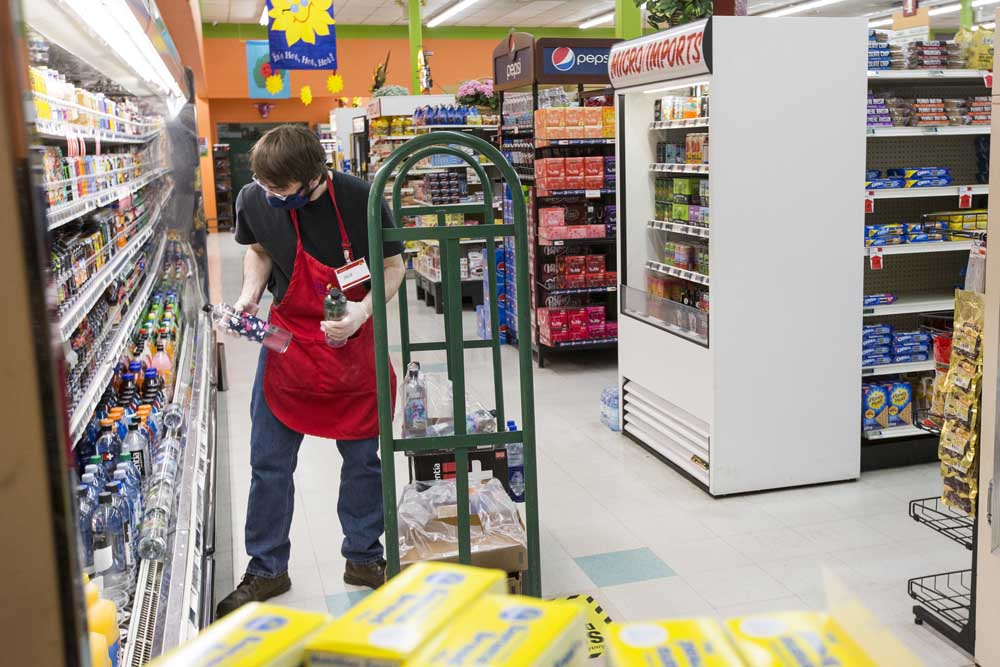Grocery store prices rise in past 12 months
Published 5:00 am Sunday, August 16, 2020

- Nick Richards works on restocking a refrigerator with drinks while working a shift at Oliver Lemon’s in Terrebonne on Saturday, Aug. 8, 2020.
For the past four months, a trip to the grocery store has been like a scavenger hunt.
Some items, like Clorox wipes, might not be on shelves again until 2021, and a search for toilet paper can turn into a quest that includes multiple stores. Other items, like produce, fill the shelves in the normal cornucopia of color.
Shortages like these are caused primarily by supply chain issues that have led to a lack of products and higher prices at grocery stores. Combined with high unemployment, it can lead to food scarcity for many residents who don’t have enough to eat.
It’s a situation that many in the industry have never experienced before, said Lauren Johnson, CEO of Newport Market.
“There’s such a demand on grocery stories and retail,” said Nick Dean, Aloha Produce director of operations. “People are stocking up on food. It’s more of a supply and demand issue.”
That supply issue has raised food prices across the country. Food prices in grocery stores have risen 4.6% over the past 12 months, according to the Bureau of Labor Statistics Consumer Price Index for July. The increase is despite a 1.1% decrease in July, the first decrease since August 2019, according to the index.
Beef rose the most over the past 12 months, according to the index, rising 14.2%. Fruits and vegetables rose, over the same period, 2.3%, and nonalcoholic beverages rose 5%.
About 10% of adults in Oregon didn’t have enough food in the week ending July 21, according to Damon Runberg, Oregon Employment Department regional economist. Food scarcity is due to the pandemic, Runberg said, because of the loss of income and inflated by supply chain issues.
“Rising food prices result in less disposable income for all of us,” Runberg said. “If I have to spend a greater share of my income on food, then I have less to spend on other things.
“A drop in discretionary spending has a ripple effect through the rest of the economy, impacting retailers and producers of other consumer goods and services.”
At Fred Meyer, there hasn’t been a spike in prices, although fresh meats have increased, said Jeffrey Temple, Fred Meyer director of corporate affairs.
“There have been some cost increases in select fresh meats due to the plant closure issues that occurred as a result of the pandemic,” Temple said. “However, we have been focused on keeping customer prices low throughout the store.”
Next week the grocery chain will launch a price reduction campaign on select food items, he said.
In all of his 45 years as a grocer, Rudy Dory, the founder of Newport Market in Bend, has never experienced this kind of supply chain disruption causing prices to rise, Johnson said.
“The prices are the ebb and flow of supply and demand,” Johnson said. “There are weeks we hear they’re canceling our order. We get multiple orders seven days away. It happens week after week.
“How that impacts us is that you see empty shelves as a consumer.”
At stores that rely solely on direct from the farms like Locavore on Third Street in Bend, there are no supply chain issues, said James Gray, Locavore market director.
“We don’t pull from large warehouses,” Gray said. “There’s no distribution. Our prices haven’t changed. They’re still pretty much the same as they were last year.”
The 75 vendors that supply the hyper-local grocery store come from as far away as Eugene, but all are direct from the farm, he said. There’s value in the local food economy, Gray said. Purchasing locally supports the local farmer and the local economy.
“People are realizing the value of a local food economy,” he said. “In times like this, people are finding the problems of those bigger food systems, and they’re turning to places like ours because they realize there’s no middle man.
“People feel safer coming here.”
Relying on the trucking industry to deliver food has been a roller-coaster ride, Dean said. Companies like Aloha Produce have had to double up on their deliveries to keep items in stock for both its retail and wholesale operations.
It’s like Easter every day, where the demand for eggs are so high that the prices go up, he said.
“There’s so much demand from grocery stores for food and a lack of drivers in the industry,” Dean said.
At Newport Market, which also operates the Oliver Lemons in Terrebonne and Sisters, the amount of customers coming in still is less than normal. But those customers are buying more.
In the early days of the pandemic, when meat was as scarce as a roll of toilet paper and flour and sugar were not to be had, the store would order larger volumes of product and repackage, Johnson said.
“We had meat the whole time,” Johnson said. “We’ve had dairy when we can; that’s our weakest link. Our produce wholesalers have been the rock star in all of all of this.
“As an independent grocer we’re nimble, unlike the big box stores who have a large supply chain.”






